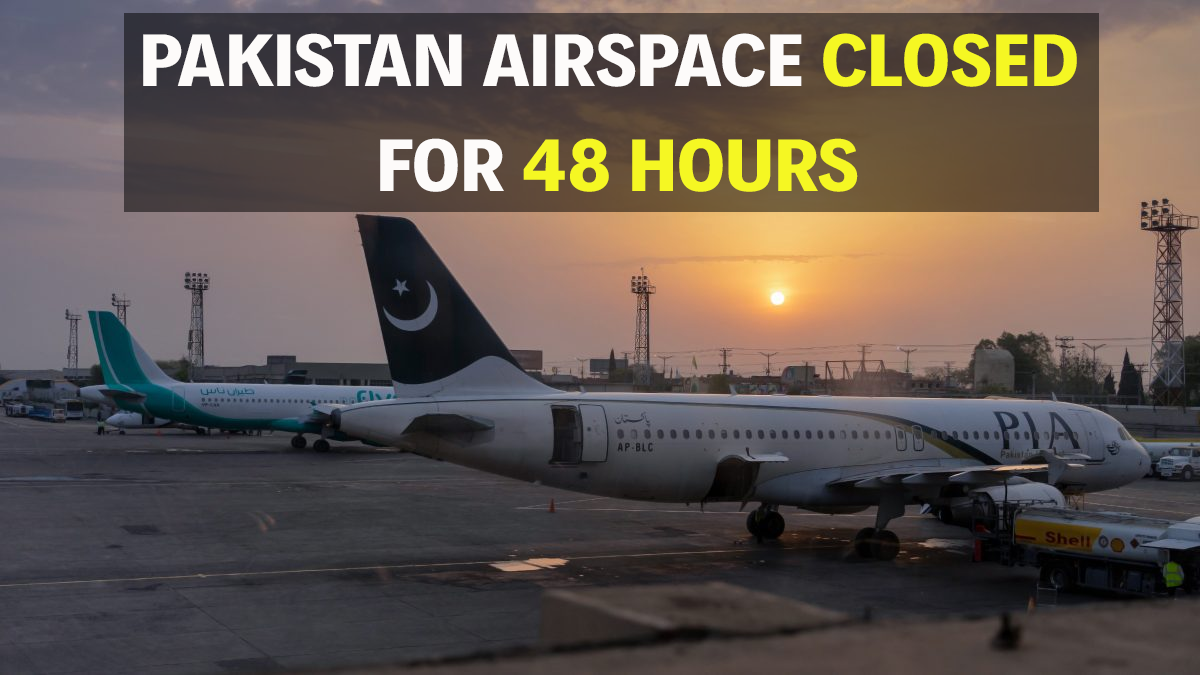
The nation of Pakistan is facing significant travel disruption as authorities have announced the closure of Pakistan's airspace for 48 hours. This unprecedented measure has resulted in all airports shutting down across the country, effective immediately. The sudden closure of Pakistani airspace and the subsequent shutdown of all airports are expected to have far-reaching consequences for both domestic and international travel, impacting countless passengers and logistical operations. This article delves into the details of this significant event, exploring the potential reasons behind the Pakistan airspace closure order, the immediate aftermath of all airports shutting down, and the anticipated impact of this 48-hour disruption.
Immediate Announcement and Implementation of the Airspace Closure
The official announcement regarding the Pakistan airspace closure directive came through a late-night notification from the relevant aviation authorities. The statement clearly indicated that due to unforeseen circumstances, the entirety of Pakistan airspace would be inaccessible for all civilian and commercial flights for the next 48 hours. Consequently, this order mandated that all airports shut down their operations, including departures, arrivals, and transit flights. The timing of the announcement has left many travelers and airlines scrambling to adjust their plans.
- The notification specified the exact start time of the Pakistan airspace closed order.
- It explicitly stated that all airports shut down with immediate effect.
- The duration of the closure of Pakistan airspace was mentioned as 48 hours.
- Airlines were advised to cease all flight operations to and from Pakistan.
- Passengers were urged to contact their respective airlines for updates and rescheduling options.
The swift implementation of the Pakistan airspace closed directive meant that many flights already en route to Pakistan were forced to divert to other nearby airports. Passengers at various airports across the globe, preparing to travel to Pakistan, found their flights abruptly cancelled due to the shutdown of all airports within the country. The 48-hour window of Pakistan airspace closed is now a critical period for authorities to manage the situation and for travelers to navigate the resulting chaos.
Potential Reasons Behind the Unforeseen Airspace Closure
While the official notification cited "unforeseen circumstances" as the reason for the Pakistan airspace closed and all airports shut down, speculation is rife regarding the specific triggers for this drastic action. Several potential factors could have contributed to the decision to close the Pakistan airspace for 48 hours:
- Security Concerns: Heightened security threats, either internal or external, could necessitate the closure of Pakistan airspace to ensure the safety and security of the nation. Such measures are often taken in response to credible intelligence regarding potential attacks or instability. The shutdown of all airports complements this by preventing any unauthorized movement or activity within aviation facilities. The 48-hour duration might be to allow security forces to conduct thorough checks and implement necessary safeguards.
- Military Exercises or Operations: Large-scale military drills or unforeseen operational requirements by the armed forces could necessitate the closure of Pakistan airspace. These activities might pose risks to civilian air traffic, making it imperative to shut down all airports as a precautionary measure. The 48-hour timeframe could align with the duration of these military activities.
- Technical Issues: Severe technical malfunctions affecting critical air traffic control systems or airport infrastructure could lead to the closure of Pakistan airspace. Ensuring the safety of air travel is paramount, and any significant technical glitch would warrant a complete shutdown of all airports until the issues are resolved. The 48 hours might be the estimated time needed for diagnosis and repair.
- Geopolitical Developments: Regional tensions or significant geopolitical events could prompt the government to close Pakistan airspace as a protective measure or as part of a broader strategic response. The shutdown of all airports would be a natural consequence of such a decision. The 48-hour period might be a preliminary duration while the situation is assessed.
- Natural Disasters: Although less likely to cause a sudden, nationwide closure of Pakistan airspace, severe weather events or natural disasters impacting multiple airport locations simultaneously could theoretically lead to a temporary shutdown of all airports. However, such scenarios usually result in localized closures rather than a blanket 48-hour ban across the entire Pakistan airspace.
The exact reason for the Pakistan airspace closed and all airports remains unconfirmed, leaving travelers and the aviation industry in a state of uncertainty. Further official statements are awaited to shed light on the specific circumstances that led to this significant disruption. The impact of these 48 hours will be substantial regardless of the underlying cause.
Impact on Domestic Air Travel within Pakistan
The closure of Pakistan airspace and the resulting shutdown of all airports have brought domestic air travel within the country to a complete standstill. Passengers who were scheduled to travel between cities such as Karachi, Lahore, Islamabad, Peshawar, and Quetta are now facing indefinite delays.
- Business travelers are unable to attend crucial meetings and conferences.
- Families are stranded, unable to reach their loved ones.
- Medical emergencies requiring air transportation are severely hampered.
- The tourism sector is experiencing immediate cancellations and losses.
The 48-hour duration of the Pakistan airspace closed will have a cascading effect on domestic flight schedules. Even after the airspace reopens and all airports resume operations, it will take a significant amount of time to clear the backlog of cancelled flights and re-accommodate stranded passengers. The inconvenience caused by this sudden shutdown of all airports is immense for the Pakistani population. The economic impact on domestic airlines and related industries due to the Pakistan airspace closed for these 48 hours will also be considerable.
Disruption to International Flights and Passengers
The closure of Pakistan airspace has had a significant ripple effect on international air travel. Pakistan's geographical location makes its airspace a crucial transit route for many international flights connecting East and West. The shutdown of all airports means that no international flights can land in or depart from Pakistan.
- Numerous international flights have been diverted to airports in neighboring countries.
- Passengers on these diverted flights are facing lengthy delays and uncertainty about their onward journeys.
- Airlines are incurring substantial costs due to diversions, passenger accommodation, and schedule disruptions.
- Passengers intending to travel to Pakistan are facing cancellations and difficulties in rebooking flights.
The 48-hourPakistan airspace closed period will affect a large number of international travelers. Business trips, holidays, and essential travel plans have been thrown into disarray. The shutdown of all airports in Pakistan has also impacted cargo flights, disrupting the supply chain and potentially affecting the import and export of goods. The longer the Pakistan airspace remains closed, the greater the economic repercussions for international trade and travel. The 48 hours are a critical window, and any extension of the shutdown of all airports would exacerbate the situation.
Impact on Cargo and Logistics Operations
The closure of Pakistan airspace and the shutdown of all airports are not just affecting passenger travel; they are also having a significant impact on cargo and logistics operations. Air cargo plays a vital role in transporting time-sensitive and high-value goods.
- Shipments of perishable goods are at risk of spoilage due to delays caused by the Pakistan airspace closed.
- The delivery of critical medical supplies and equipment is being hampered by the shutdown of all airports.
- Manufacturing supply chains that rely on air freight are facing disruptions.
- E-commerce deliveries involving international air transport are experiencing significant delays.
The 48-hourclosure of Pakistan airspace has created a bottleneck in the movement of goods. Even after all airports reopen, it will take time to clear the backlog of cargo and restore normal logistics operations. The economic cost of this disruption to trade and commerce due to the Pakistan airspace closed for these 48 hours could be substantial.

Communication and Information Dissemination to the Public
During this period of Pakistan airspace closed and all airports shut down, effective communication and information dissemination are crucial. Passengers and the general public need timely and accurate updates regarding the situation.
- Airlines are responsible for informing their passengers about flight cancellations and providing assistance with rebooking or refunds.
- Airport authorities need to manage the situation on the ground, providing information and support to stranded passengers.
- Government agencies should issue regular updates on the reasons for the Pakistan airspace closed and the expected duration of the shutdown of all airports.
- Media outlets play a vital role in disseminating information and keeping the public informed about the evolving situation.
The 48-hourclosure of Pakistan airspace necessitates clear and consistent communication to mitigate confusion and anxiety among travelers. The efficiency of information dissemination will be a key factor in how well the situation is managed during and after the shutdown of all airports.
Potential Economic Consequences of the Airspace Closure
The closure of Pakistan airspace for 48 hours and the subsequent shutdown of all airports are likely to have significant economic consequences.
- Airlines will face substantial financial losses due to flight cancellations, diversions, and passenger compensation.
- The tourism industry will suffer from cancellations of bookings and a decline in visitor arrivals.
- Businesses that rely on air travel for meetings, conferences, and client interactions will experience disruptions.
- The disruption to cargo flights will impact international trade and supply chains.
- The overall economic activity could be negatively affected due to reduced connectivity and business uncertainty.
The 48-hourPakistan airspace closed period, while seemingly short, can still have a considerable economic impact. If the shutdown of all airports is extended beyond this initial timeframe, the economic repercussions will become even more severe. The long-term effects will depend on the reasons for the closure and the speed at which normal air traffic is restored after the 48 hours.
Historical Instances of Airspace Closures and Their Impacts
While a nationwide closure of Pakistan airspace and the shutdown of all airports for such a duration might be unprecedented, there have been historical instances of airspace closures in other parts of the world due to various reasons. Examining these past events can provide some context for the potential impacts of the current situation.
| Reason for Closure | Location | Duration | Impact |
|---|---|---|---|
| Volcanic Ash Cloud | Europe | Several Days | Massive flight cancellations, economic losses for airlines and tourism. |
| Terrorist Attacks | United States | Several Days | Complete grounding of civilian aircraft, significant travel disruption. |
| Military Conflicts | Various Regions | Variable | Airspace restrictions, diversions, safety concerns. |
| Political Instability | Various Regions | Variable | Flight cancellations, safety advisories, impact on tourism. |
| Global Pandemic (COVID-19) | Worldwide | Weeks/Months | Unprecedented travel restrictions, near-total shutdown of air travel. |
These historical examples highlight the significant disruptions and economic consequences that can arise from airspace closures. The 48-hourclosure of Pakistan airspace and the shutdown of all airports, while hopefully shorter than some of these past events, will still have a considerable impact on travel, trade, and the economy.
Contingency Plans and Recovery Efforts
Authorities and airlines will be working on contingency plans to mitigate the impact of the Pakistan airspace closed and the shutdown of all airports. Once the 48-hour period ends and the airspace reopens, a coordinated effort will be required to restore normal operations.
- Airlines will need to reschedule flights and clear the backlog of stranded passengers.
- Airports will need to manage the surge in traffic and ensure smooth processing of passengers.
- Air traffic control will need to handle the increased volume of flights safely and efficiently.
- Communication with the public will remain crucial to provide updates on the resumption of services.
The recovery process after the 48-hourclosure of Pakistan airspace and shutdown of all airports will be complex and may take several days to fully normalize. Passengers are advised to remain in contact with their airlines for the latest information regarding their travel plans.
The Human Element: Stranded Passengers and Their Stories
The sudden closure of Pakistan airspace and the shutdown of all airports have had a direct and personal impact on countless individuals. Stories of stranded passengers are beginning to emerge, highlighting the human cost of this disruption.
- A family on their way to a long-awaited vacation is stuck at a transit airport, unsure of when they can continue their journey.
- A business professional is unable to attend a critical meeting, potentially jeopardizing important deals.
- A student trying to return home for the holidays is stranded far from their destination.
- Individuals with medical emergencies requiring timely travel face immense uncertainty due to the shutdown of all airports.
These personal stories underscore the significant inconvenience and distress caused by the 48-hourclosure of Pakistan airspace. While the reasons behind this decision are undoubtedly serious, the impact on individuals' lives is undeniable.
Looking Ahead: The Next 48 Hours and Beyond
The next 48 hours will be crucial in understanding the full implications of the Pakistan airspace closed and the shutdown of all airports. The focus will be on:
- Official Announcements: Awaiting further details from the authorities regarding the reasons for the closure and any potential extensions.
- Passenger Welfare: Ensuring that stranded passengers receive adequate information and assistance from airlines and airport authorities.
- Operational Planning: Airlines and airports developing and implementing plans for the resumption of services once the 48-hour period ends.
- Economic Assessment: Analyzing the immediate economic impact of the disruption on various sectors.
Beyond the initial 48 hours, the long-term consequences will depend on the underlying reasons for the Pakistan airspace closed and how quickly normalcy can be restored. The aviation industry and travelers will be closely monitoring the situation.
Summary of the Situation: Pakistan Airspace Closed for 48 Hours
In summary, the closure of Pakistan airspace for 48 hours has led to a complete shutdown of all airports across the country. This unprecedented action is causing significant disruption to domestic and international air travel, impacting passengers, airlines, and cargo operations. The reasons for the Pakistan airspace closed remain officially unspecified, leading to speculation about potential security concerns, military activities, technical issues, geopolitical developments, or even natural disasters. The 48-hour duration of this shutdown of all airports is creating a backlog of stranded passengers and cargo, with potentially significant economic consequences. Effective communication and well-coordinated recovery efforts will be essential once the Pakistan airspace reopens after the initial 48 hours. The situation is being closely monitored by travelers, the aviation industry, and the international community. The full impact of these 48 hours of Pakistan airspace closed and all airports shut down will become clearer in the days and weeks to come.
;More Travel News
-
 27-Jun-2025Navigating Global Horizons: Visa-Free and Visa-on-Arrival Opportunities for Pakistani Passport Holders in 2025
27-Jun-2025Navigating Global Horizons: Visa-Free and Visa-on-Arrival Opportunities for Pakistani Passport Holders in 2025 -
 19-May-2025New Umrah Season to Begin June 11: Saudi Arabia Releases 1447H Calendar with Visa and Package Details
19-May-2025New Umrah Season to Begin June 11: Saudi Arabia Releases 1447H Calendar with Visa and Package Details -
 22-Aug-2025A New Era of Connectivity: The Launch of New Flight Routes to Jeddah and Madinah
22-Aug-2025A New Era of Connectivity: The Launch of New Flight Routes to Jeddah and Madinah -
 16-Apr-2025PIA adds Lahore-Baku direct flights to its schedule.
16-Apr-2025PIA adds Lahore-Baku direct flights to its schedule. -
 31-Jul-2019The World Is A Book And Those Who Do Not Travel Read Only One Page
31-Jul-2019The World Is A Book And Those Who Do Not Travel Read Only One Page -
 01-Oct-2025Guide to the New Umrah Visa Rules 2025: Mandatory Hotel and Transport Bookings
01-Oct-2025Guide to the New Umrah Visa Rules 2025: Mandatory Hotel and Transport Bookings -
 17-Aug-2021UAE Offers On Arrival Visa To The Passengers From 70 Countries
17-Aug-2021UAE Offers On Arrival Visa To The Passengers From 70 Countries -
 15-Nov-2024Lahore Airport Shrouded in Fog: Flights Delayed, Cancelled
15-Nov-2024Lahore Airport Shrouded in Fog: Flights Delayed, Cancelled -
 22-Apr-2020Saudi Arabia Allow to Offer 10 Rakats Taraweeh Prayers
22-Apr-2020Saudi Arabia Allow to Offer 10 Rakats Taraweeh Prayers -
 06-Sep-202512 Rabi ul Awwal Celebrations in Pakistan and Worldwide – A Day of Blessings
06-Sep-202512 Rabi ul Awwal Celebrations in Pakistan and Worldwide – A Day of Blessings -
 31-Mar-2020Coronavirus Seems Unbeatable As Cases Rise to 1,865 in Pakistan
31-Mar-2020Coronavirus Seems Unbeatable As Cases Rise to 1,865 in Pakistan -
 19-Apr-2024Dubai underwater: Hundreds of flights canceled or delayed
19-Apr-2024Dubai underwater: Hundreds of flights canceled or delayed
